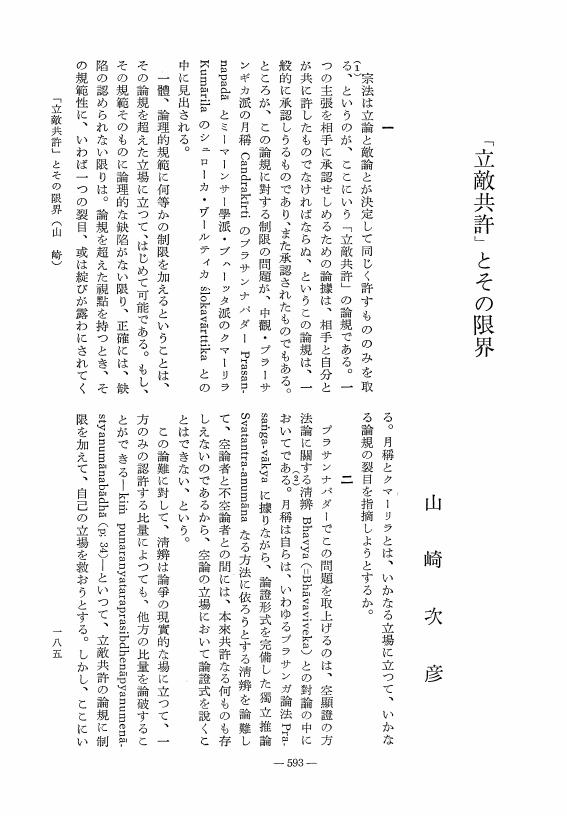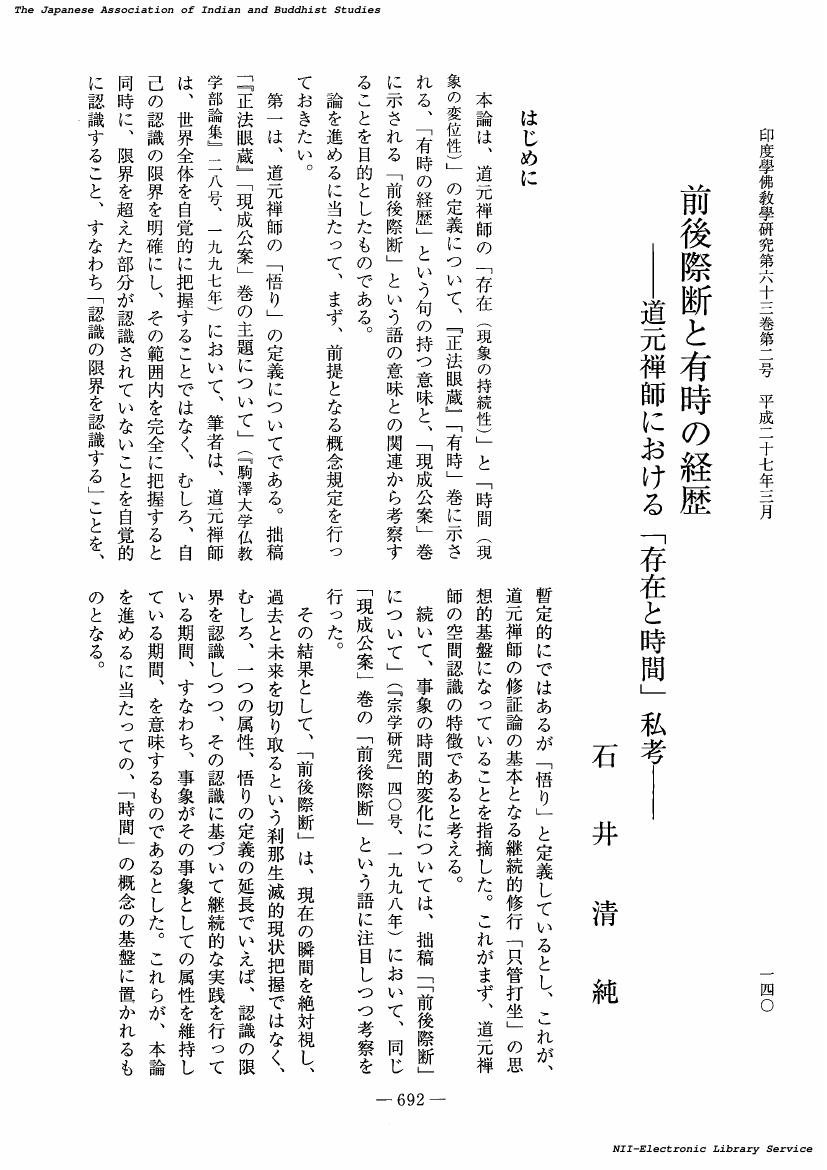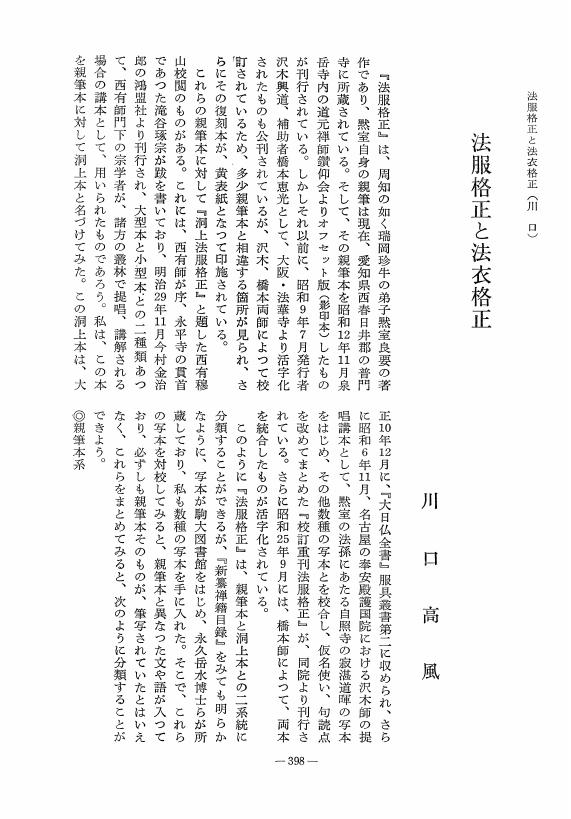1 0 0 0 中世日蓮宗における本尊の造像について
- 著者
- 寺尾 英智
- 出版者
- 日本印度学仏教学会
- 雑誌
- 印度學佛教學研究 (ISSN:00194344)
- 巻号頁・発行日
- vol.65, no.1, pp.120-128, 2016
<p>Ittō ryōson 一塔両尊 is a style of <i>honzon </i>本尊, the main object of worship. It is a characteristic style of the medieval Nichiren sect. Ittō ryōson has the Daimoku 題目, and the calligraphy <i>Namu Myōhō Renge Kyō</i> 南無妙法蓮華経 in the center, and two Buddhas, Śākyamuni and Prabhūtaratna, on both sides. The style which has Śākyamuni and Prabhūtaratna on both sides itself is not peculiar to the Nichiren sect. It is based on the <i>Lotus Sutra</i>. However, Ittō ryōson is formed from the kernel of the Mandara honzon 曼荼羅本尊 designed by Nichiren 日蓮. There are some combinations of Śākyamuni's and Prabhūtaratna's <i>inzō</i> 印相, mudra. Ittō ryōson also has some varieties of <i>inzō</i>. Moreover, Ittō ryōson is the only instance in which both Śākyamuni and Prabhūtaratna in <i>gasshō-in</i> 合掌印. One instance of Ittō ryōson in which both Śākyamuni and Prabhūtaratna are so depicted was made in 1335. This style spread as peculiar to the Nichiren sect.</p>
1 0 0 0 OA 七宝について
- 著者
- 定方 晟
- 出版者
- Japanese Association of Indian and Buddhist Studies
- 雑誌
- 印度學佛教學研究 (ISSN:00194344)
- 巻号頁・発行日
- vol.24, no.1, pp.84-91, 1975-12-25 (Released:2010-03-09)
1 0 0 0 OA ジャータカにみる手紙
- 著者
- 水野 善文
- 出版者
- Japanese Association of Indian and Buddhist Studies
- 雑誌
- 印度學佛教學研究 (ISSN:00194344)
- 巻号頁・発行日
- vol.54, no.1, pp.382-375,1271, 2005-12-20 (Released:2010-03-09)
- 参考文献数
- 17
The aim of this paper is to contribute to the knowledge of the development of literacy in ancient India by researching the custom of writing epistles found in the Pall Jataka. Because this text contains many descriptions of epistles, some of which were written by townsmen and a merchant's wife, we can assume that the custom of writing epistles was more widespread than our current estimate. We can also find some indication regarding the types of materials that were used for writing epistles. Since we are aware of only two examples in canonical verses (gatha) and others in later commentaries (Jatakatthavannana, etc.), we cannot definitely ascertain the inception and duration of the custom of writing epistles in India. However, this research can help us acquire other information on this phase of development of literacy in ancient India.
1 0 0 0 OA 夜叉信仰の背景
- 著者
- 高橋 堯昭
- 出版者
- Japanese Association of Indian and Buddhist Studies
- 雑誌
- 印度學佛教學研究 (ISSN:00194344)
- 巻号頁・発行日
- vol.37, no.2, pp.585-591, 1989-03-20 (Released:2010-03-09)
1 0 0 0 OA 仏陀の最初説法と慈悲
- 著者
- 新井 一光
- 出版者
- 日本印度学仏教学会
- 雑誌
- 印度學佛教學研究 (ISSN:00194344)
- 巻号頁・発行日
- vol.67, no.1, pp.487-482, 2018-12-20 (Released:2019-09-07)
- 参考文献数
- 7
Because the Chinese translations of the Dharmaguptaka Vinaya and Mahīśāsaka Vinaya lack any equivalent of the term “being a compassionate one” (kāruññatā), which expresses the motivation for the Buddha’s first sermon in current Pāli texts, and because Śākyamuni had no consideration for others leading up to attaining his enlightenment, the phrase “ca ...... sattesu ca kāruññataṃ paṭicca” was likely added by later generations. This shows that compassion as a motivation behind the Buddha’s first sermon cannot be traced directly back to Śākyamuni himself. Therefore, it is understood that the Buddha’s first sermon is not based on compassion.Between the two motives of “Brahmā’s entreaty” and “kāruññatā”, the latter only holds any significance when occurring after Brahmā’s entreaty. Therefore, it is likely wrong to treat the idea of having compassion towards others as the same as recognizing Brahmā’s entreaty when trying to understand the motivation behind the Buddha’s first sermon. However, if one were to explore the intentions of the authors of the Pāli texts, I suppose Buddhists who understood the motive of “ca ...... sattesu ca kāruññataṃ paṭicca” were critical of the motivation behind the Buddha’s first sermon expressed by the Brahmā’s entreaty and held a negative view of its significance.
1 0 0 0 OA 「立敵共許」とその限界
- 著者
- 山崎 次彦
- 出版者
- Japanese Association of Indian and Buddhist Studies
- 雑誌
- 印度學佛教學研究 (ISSN:00194344)
- 巻号頁・発行日
- vol.8, no.2, pp.593-597, 1960-03-30 (Released:2010-03-09)
1 0 0 0 OA ミャンマー華人の宗教
- 著者
- 平木 光二
- 出版者
- Japanese Association of Indian and Buddhist Studies
- 雑誌
- 印度學佛教學研究 (ISSN:00194344)
- 巻号頁・発行日
- vol.49, no.1, pp.337-333, 2000-12-20 (Released:2010-03-09)
1 0 0 0 中古天台における教行證について
- 著者
- 小方 道憲
- 出版者
- 日本印度学仏教学会
- 雑誌
- 印度學佛教學研究 (ISSN:00194344)
- 巻号頁・発行日
- vol.2, no.2, pp.518-519, 1954
1 0 0 0 十住毘婆沙論の教行證
- 著者
- 藤谷 大圓
- 出版者
- 日本印度学仏教学会
- 雑誌
- 印度學佛教學研究 (ISSN:00194344)
- 巻号頁・発行日
- vol.3, no.1, pp.146-147, 1954
1 0 0 0 OA 立山信仰について
- 著者
- 沼 賢亮
- 出版者
- Japanese Association of Indian and Buddhist Studies
- 雑誌
- 印度學佛教學研究 (ISSN:00194344)
- 巻号頁・発行日
- vol.16, no.2, pp.616-617, 1968-03-31 (Released:2010-03-09)
1 0 0 0 OA 前後際断と有時の経歴 ――道元禅師における「存在と時間」私考――
- 著者
- 石井 清純
- 出版者
- 日本印度学仏教学会
- 雑誌
- 印度學佛教學研究 (ISSN:00194344)
- 巻号頁・発行日
- vol.63, no.2, pp.692-699, 2015-03-20 (Released:2017-09-01)
1 0 0 0 OA 良遍の地蔵信仰
- 著者
- 清水 邦彦
- 出版者
- Japanese Association of Indian and Buddhist Studies
- 雑誌
- 印度學佛教學研究 (ISSN:00194344)
- 巻号頁・発行日
- vol.43, no.1, pp.164-167, 1994-12-20 (Released:2010-03-09)
1 0 0 0 OA 『プラマーナヴィニシュチャヤ』第3章におけるダルマキールティの帰謬論証
- 著者
- 吉水 千鶴子
- 出版者
- Japanese Association of Indian and Buddhist Studies
- 雑誌
- 印度學佛教學研究 (ISSN:00194344)
- 巻号頁・発行日
- vol.64, no.3, pp.1246-1254, 2016-03-25 (Released:2017-09-01)
- 被引用文献数
- 1
ダルマキールティはその著書『プラマーナヴィニシュチャヤ』第3章「他者のための推論」の中で,帰謬論証の例をあげる.帰謬(プラサンガ)論証は対論者の主張を論駁するためのものであり,相手の主張から主題とその属性を借用し,それを前提条件として,そこから相手にとって不合理な結論を導き,相手の主張の矛盾を指摘することにより論駁する仮言論証である.ダルマキールティも帰謬論証が対論者によって構想された属性にもとづくことは認めているが,彼が提示する論証式は以下の点で,それまでの帰謬論証とは大きく性格を異にする.(1)論証因を用いること,(2)仮言的表現を用いないこと,(3)遍充関係に相当する論証因と帰結の二つの属性の必然的関係が肯定的否定的遍充の両方で示されること,(4)その必然的関係は実在にもとづくこと.さらに,ダルマキールティが考える「論証因」は,借り物の主題の属性にはなり得ないが,そのような主題を離れれば,正しい認識(プラマーナ)によって成立し,対論者立論者両方によって認められるものである.その「論証因」から必然的に導き出される帰結は論理的帰結であり,誰もが認めざるを得ないものである.このような論証因の導入は革新的なことであったが,これなくして説得力をもった対論者の論駁はなしえないとダルマキールティは考えたのであろう.本論文は,このような彼の意図を明らかにすると同時に,彼が用いる「本性」(svabhava)という語は自らの存在そのものを指すのではないか,また「本来的論証因」(maulahetu)は「自らの理解,認識に根ざした論証因」すなわち他者のための推論にいうところの「自ら認めたもの」(svadrstartha)を指すのではないか,という解釈を提示した.
1 0 0 0 OA 法服格正と法衣格正
- 著者
- 川口 高風
- 出版者
- Japanese Association of Indian and Buddhist Studies
- 雑誌
- 印度學佛教學研究 (ISSN:00194344)
- 巻号頁・発行日
- vol.24, no.1, pp.398-401, 1975-12-25 (Released:2010-03-09)
1 0 0 0 のろんじ考 -呪禁師のながれ-
- 著者
- 岩佐 貫三
- 出版者
- 日本印度学仏教学会
- 雑誌
- 印度學佛教學研究 (ISSN:00194344)
- 巻号頁・発行日
- vol.24, no.1, pp.414-417, 1975
1 0 0 0 後期中観派に見る正理と勝義
- 著者
- 那須 真裕美
- 出版者
- 日本印度学仏教学会
- 雑誌
- 印度學佛教學研究 (ISSN:00194344)
- 巻号頁・発行日
- vol.53, no.2, pp.842-839, 2005
1 0 0 0 OA 二つの長者窮子喩
- 著者
- 鈴木 隆泰
- 出版者
- Japanese Association of Indian and Buddhist Studies
- 雑誌
- 印度學佛教學研究 (ISSN:00194344)
- 巻号頁・発行日
- vol.63, no.3, pp.1263-1270, 2015-03-25 (Released:2017-09-01)
『法華経』の「法華七喩」の中に,有名な長者窮子喩がある.一方,『法華経』や『涅槃経』等の影響下に作成された,如来蔵系経典である『大法鼓経』にも長者窮子喩が説かれている.両者には共通点も多い反面,最大の相違点として,『法華経』の長者窮子喩では,貧者は長者の家で仕事をしつつも財産を望まず,長者から真実を告げられ,思いもかけずに相続者となるのに対し,『大法鼓経』では,長者から真実を聞かされる前であったにもかかわらず,貧者は自発的に財産の相続者となることを望み,そして長者から真実を告げられ,望み通りに相続者となる,という点が挙げられる.この『大法鼓経』の長者窮子喩は,実子で〔あると〕は〔まだ知らされてい〕ない者が相続者になりたいと自ら望むという点において,血統・家柄を重んじるインド社会の価値観から見て非常に不自然であるとの指摘もなされてきた.本研究では長者窮子喩のみに限らず,両経典の一乗や解脱を巡る教説を辿ることによって,両者の異同の理由を探った.以下に結論を提示する.『法華経』は,一乗・一切皆成の根拠を衆生の外側(諸仏の誓願)に見出している.そのため衆生は,一切皆成であると「諸仏に教えてもらわなければならない」.これが,貧者が長者から教えられて,自分が息子・財産の継承者であったことがはじめて分かるという構図に連なっている.なお,一乗を主張するためには,すでに解脱を得ている阿羅漢の成仏も保証しなければならない.そのため『法華経』は,"解脱した者はもう二度と解脱できない"という従来の理解に挑戦することとなり,結果,それまでの「常識,前提」を覆し,「輪廻からの離脱は真の解脱ではない」「三界を離脱しても不死ではなく再生する」という驚くべき説を提唱するに至った.一方の『大法鼓経』は,『法華経』の提唱した「成仏するまでは複数回解脱できる」という説を継承しながらも,一乗・一切皆成の根拠については『法華経』とは異なり,「衆生の内側に実在する如来蔵・仏性」に見出している.そのため,「教えられずとも衆生(貧者)の側から成仏(財産)を求める」という構図を描くことが可能となった.さらには,如来蔵・仏性思想の一大特徴として,そもそもこの思想自体が「如来目線の教え」であることも関係していると思われる.如来であれば,他より教えられずとも一切皆成を最初から知っているからである.『法華経』とは異なり,『大法鼓経』の長者窮子喩が仏弟子ではなく釈尊の所説となっていることも,この仮説を支えるものと判断される.たしかに『大法鼓経』の長者窮子喩には,血統主義に立脚するインド社会・世間的価値からは「非常識」とも見なされる面がある.しかしインド仏教には,「如来=父,仏弟子=実子」という,世俗の親子関係を超えた「出世間の親子関係」という考え方が伝統的に存在していた.この伝統に照らし合わせるとき,『法華経』よりもむしろ『大法鼓経』の長者窮子喩の方が,出家主義・行為主義を標榜するインド仏教の文脈により沿うものといえる.
1 0 0 0 シャンカラの『ヨーガ・スートラ註解書解明』(下)
- 著者
- 中村 元
- 出版者
- 日本印度学仏教学会
- 雑誌
- 印度學佛教學研究 (ISSN:00194344)
- 巻号頁・発行日
- vol.26, no.1, pp.119-127, 1977
1 0 0 0 シャンカラの『ヨーガ・スートラ註解書解明』(上)
- 著者
- 中村 元
- 出版者
- 日本印度学仏教学会
- 雑誌
- 印度學佛教學研究 (ISSN:00194344)
- 巻号頁・発行日
- vol.25, no.1, pp.70-77, 1976
1 0 0 0 OA 時衆と神祗 -特に二祖真教の熊野神に対する態度-
- 著者
- 大橋 俊雄
- 出版者
- Japanese Association of Indian and Buddhist Studies
- 雑誌
- 印度學佛教學研究 (ISSN:00194344)
- 巻号頁・発行日
- vol.18, no.2, pp.728-730, 1970-03-31 (Released:2010-03-09)








